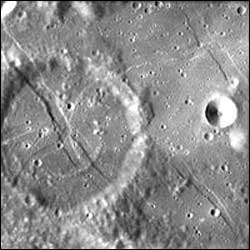Tectonic ‘wrinkles’ in Crater De Gasparis

Crater De Gasparis as seen by SMART-1
The image, taken by the Advanced Moon Imaging Experiment (AMIE) on board ESA’s SMART-1 spacecraft, shows Crater De Gasparis on the Moon.
The AMIE camera obtained this image on 14 January 2006 from a distance of about 1090 kilometres with a ground resolution of approximately 100 metres per pixel.
Crater De Gasparis is located close to the Mare Humorum, at longitude 51.2° West and latitude 26.0° South, on the lower left quarter of the Moon’s Earth-facing side. It has a diameter of about 30 kilometres and can be seen with the naked eye from Earth.
The criss-cross patterns in it are called ‘rilles’ (these are features where the surface has sunk down to form a trench).
These rilles coincide with deep tectonic faults that have been active over a long period of lunar geological evolution. They are the result of stresses due to all the tidal forces and volcanic expansion over the lunar mantle during the last stages of lava flooding of Oceanus Procellarum.
The fact that the rilles cross the crater means that they formed after the crater. This is a good example for how geologists can determine the relative history of the Moon’s surface.
This crater is named after the Italian astronomer Annibale de Gasparis (1819-1892). De Gasparis was director of the observatory in Naples, Italy.
Media Contact
More Information:
http://www.esa.int/SPECIALS/SMART-1/SEME93OVGJE_0.htmlAll latest news from the category: Physics and Astronomy
This area deals with the fundamental laws and building blocks of nature and how they interact, the properties and the behavior of matter, and research into space and time and their structures.
innovations-report provides in-depth reports and articles on subjects such as astrophysics, laser technologies, nuclear, quantum, particle and solid-state physics, nanotechnologies, planetary research and findings (Mars, Venus) and developments related to the Hubble Telescope.
Newest articles

Recovering phosphorus from sewage sludge ash
Chemical and heat treatment of sewage sludge can recover phosphorus in a process that could help address the problem of diminishing supplies of phosphorus ores. Valuable supplies of phosphorus could…

Efficient, sustainable and cost-effective hybrid energy storage system for modern power grids
EU project HyFlow: Over three years of research, the consortium of the EU project HyFlow has successfully developed a highly efficient, sustainable, and cost-effective hybrid energy storage system (HESS) that…

After 25 years, researchers uncover genetic cause of rare neurological disease
Some families call it a trial of faith. Others just call it a curse. The progressive neurological disease known as spinocerebellar ataxia 4 (SCA4) is a rare condition, but its…





















